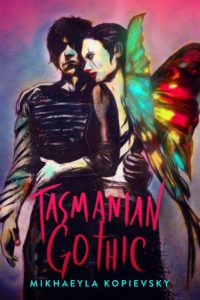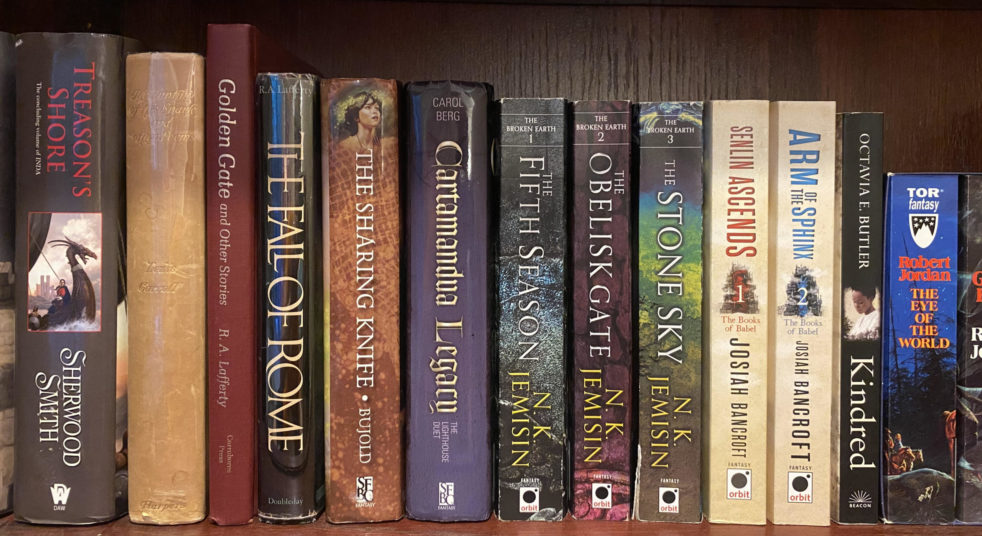
My judging team for the third annual Self-Published Science Fiction Competition (SPSFC3) has scouted our entire allotment and selected seven books to be passed around the team for full evaluations by our entire complement of judges. As I read two of the seven in the scouting phase, that will mean five new reads for me personally, all books that either got thumbs up from multiple scouts or had one of my teammates really go out on a limb in favor of it. Perhaps my most anticipated of those five was Tasmanian Gothic by Mikhaeyla Kopievsky, which had one rave review and a second positive one from its initial scouts and promised a focus on familial relationships that I often enjoy in my sci-fi.
Tasmanian Gothic takes place in a dystopian future Tasmania, where radiation has spawned rampant mutations in the southern portion of the island, a development sparking the North to build a wall to keep themselves safe. Those behind the wall live in fear of mutants and the two warring crime bosses that control most of the territory. Fortunately, the lead’s facility harnessing mutated biological material to make drugs has kept her alive so far. Unfortunately, it hasn’t erased her debt to the mob, and protection from her vengeful ex is going to cost even more, bringing her to the point where escape by any means seems the only choice remaining.
Tasmanian Gothic quickly draws the reader into the lead’s plight with a visceral prose style that hits hard at the beginning and doesn’t let up for the entire length of the novel. Apart from a couple linguistic tics repeated one too many times, there wasn’t much to complain about with sentence-level writing that consistently brought the scenes to life in vivid detail. Even if the rest had been terrible (and it wasn’t), the quality of the individual scenes would’ve justified its place in the quarterfinals. Unfortunately, I had a harder time appreciating those scenes’ places within the novel’s broader structure. Part of that may come down to personal preference: I don’t much like thriller plot structures, and Tasmanian Gothic has a thriller plot structure. The lead is dragged from peril to peril, largely due to external forces and not to her own agency, giving the overall novel the feel of a series of action sequences loosely strung together, in a world that has room for only one story.
That structure can work, if the action scenes are good and the character motivations are compelling. And Tasmanian Gothic succeeds in the former—though again, as someone who isn’t a big fan of action, its success may not impact me like it would a better thriller audience—but it’s much more mixed in the latter. Make no mistake, it is certainly easy to sympathize with the lead in her plight. After all, she’s being threatened on all sides, mostly through no fault of her own, and is motivated by desires for freedom and family. It’s the actions of the antagonists and the general shape of that purported freedom that are harder to swallow. It feels at times like the antagonists threaten just because they’re antagonists, and not because of any more explicable motivation. The vengeful ex is simple enough to understand, as is a mob boss trying to avoid losing a key asset. But the latter’s actions are so unnecessarily cruel as to drive that asset away, and the subsequent encounters that drive her away from a purported place of safety seem almost utterly random. Certainly, bad things regularly happen without good reason. But there comes a point where the novel seems to be made up almost entirely of bad things happening for no good reason, and it keeps the overarching plot from hanging together as well as it otherwise might have.
The target of the lead’s quest is similarly confusing. The desire for freedom is well and good, and getting out of her home at all costs makes perfect sense, given those in pursuit. But the walled North is treated like a land of promise, one people will risk their lives to attain, even knowing the land’s reputation for enslaving those who make it past the wall. Sure, there may be opportunity. Sure, much of the South is slavery by another name. But treating escape like the be-all, end-all solution is hard to understand, contributing to a flight that often seemed more danger than it was worth and an ending that felt rather abrupt.
Overall, the visceral prose and heart-pounding flight through dystopian Tasmania offer plenty to love for fans of action-heavy thrillers. But the character motivations are so lightly sketched as to flatten the story, with mustache-twirling antagonists and a plot that seems to serve the action scenes rather than the other way around. It’s book with plenty of strengths, but it’s ultimately a bit unbalanced.
Recommended if you like: post-apocalyptic thrillers, visceral prose.
Can I use it for Bingo? It’s hard mode for Self-Published.
Overall rating: 13 of Tar Vol’s 20. Three stars on Goodreads.
SPSFC score: 6.5/10 for my personal score. The official team score will be determined in concert with my teammates.
